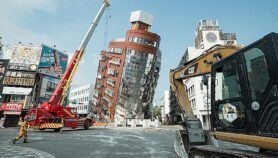Send to a friend
The details you provide on this page will not be used to send unsolicited email, and will not be sold to a 3rd party. See privacy policy.
[SANTIAGO] Chilean scientists have developed a device that can help protect tall buildings from the effects of an earthquake.
The device is made of flexible metal plates bent into a U shape, which connect different parts of a building’s structural support system. When the building moves laterally, the plates deform and then return to their original shape, dissipating the seismic energy that would otherwise damage the building.
The plates proved their worth during February’s earthquake in Santiago, when Chile’s tallest skyscraper, the Titanium La Portada Tower — a 52-storey, 190-metre-high building that was fitted with 45 of the devices — survived intact.
The devices were developed by researchers from the Department of Structural and Geotechnical Engineering at the Catholic University, Santiago, and have been patented by the country’s National Industrial Property Institute.
They are suited to relatively flexible structures, such as buildings of ten storeys or more. And their shape means they can adapt to the design requirements of a building.
Henry Sady, a structural engineer at Sirve S. A., a consultancy firm spawned by the university, told SciDev.Net: "The geometry of our devices allows them to deform much more and dissipate a greater amount of seismic energy than similar technologies." This means the devices do not have to be fitted on every floor, reducing installation costs.
Additionally, the devices suffer little or no damage even during long and powerful tremors, a feature that drastically reduces their maintenance cost.
"The cost of installing them — less than 1 per cent of the cost of the building — is insignificant considering their benefits," said Sady.
Joe Colaco, president of the structural-engineering consulting firm CMB Engineers, says the technology also reduces the damage to non-structural items of the building, such as partitions and the façade.
Many countries, including Argentina, Colombia, Guatemala, Mexico and Peru, have contacted Sirve S. A. about the technology and are considering buying it, Sady said.













